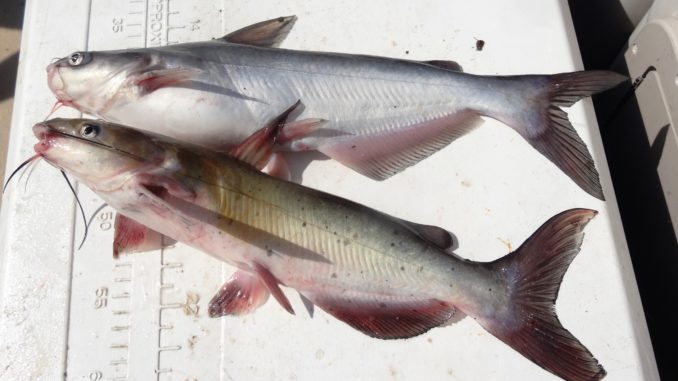How to Tell a Blue Catfish From a Channel Catfish

Color and shape of anal fins are easiest ways to distinguish between the species
One of the biggest questions anglers often raise when they boat a catfish is whether they've caught a blue catfish or channel catfish, because there are distinct similarities in appearance, beginning with the forked tail. Some fishermen even refer to them, collectively, as "blue channel catfish." They are found throughout South Carolina in the same waters and are often caught on the same baits, but armed with a bit of information, they can be easy to distinguish.
Chad Holbrook, a fisheries biologist for the S.C. Department of Natural Resources out of Bonneau said blue catfish were introduced by SCDNR to the Santee Cooper lakes in 1964. South Carolina traded striped bass fry to the Arkansas Game and Fish Commission for 180 juvenile blue catfish.
"Both species are found throughout South Carolina, and although the blues were only stocked in Santee Cooper, they have found their way to most major reservoirs," Holbrook said. "Channel catfish were thought to be a native species, but more recent genetic research indicates they may also be an introduced species. Fisheries biologists are unclear on whether or not they are native to fresh waters in South Carolina, however they have been swimming in South Carolina waters for much longer than blue catfish."
Holbrook said size of the fish alone is not the primary identification factor unless the fish is huge, then it's likely to be a blue catfish.
"The blue catfish can get well over 100 pounds under the right conditions, and the world record for channel catfish is 58 pounds, at Santee Cooper," he said. "But overall, channel catfish in excess of the 20-pound class are quite unusual in South Carolina. Twenty-pound blue catfish are quite common.
"To begin with, both have a forked tail, as opposed to flatheads and bullheads," he said. "Body shapes have some similarities but actually are quite distinct. But identification is easy when you put color, anal fin shape and number of rays in the anal fin into the defining description."
Holbrook said the blue catfish is a slate blue to almost white color, with most fish having shading from blue to white towards the belly.
"A real key that's easy to identify is if the anal fin is straight or flat," Holbrook said. "Plus there are 30 to 36 rays in the anal fin, and there are no dark spots on the blue catfish.
"The channel catfish is olive brown to gray in color," he said. "But the anal fin is rounded, very distinct from the blue catfish and a key that many anglers can quickly rely on in terms of identification. There are only 24 to 29 rays on the anal fin and often, not always, the channel catfish will have dark spots on the skin. Usually that is a good way to distinguish between the two, but a lot of larger channel catfish will not have any spots.
"That's where the coloration and anal fin can be used to make an easy identification," Holbrook said.
While it's not a specific distinguishing characteristic, catfishing experts can often distinguish between the bite of a channel and blue catfish.
Guide Rodger Taylor (803-328-9587), a student of the catfish species, said channel catfish will often sample or hit the bait a couple times before committing and taking the bait.
"A blue catfish, especially larger blues, will typically hit like a freight train," Taylor said. "That's not a set in stone method to distinguish species from the bite, but I can tell the species from the bite most of the time.
"Both species are good, fighting fish, but pound-for-pound, the channels probably fight harder, but the blues grow bigger," he said. "Both make excellent table fare, and between the two, they add an extra dimension to catfishing we didn't have in the past, so I'm glad we have both."
JOIN THE CLUB, get unlimited access for $2.99/month
Become the most informed Sportsman you know, with a membership to the Carolina Sportsman Magazine and CarolinaSportsman.com.
Source: https://www.carolinasportsman.com/fishing/freshwater-fishing/blue-cat-or-channel-telling-them-apart-doesnt-have-to-be-difficult/
Post a Comment for "How to Tell a Blue Catfish From a Channel Catfish"